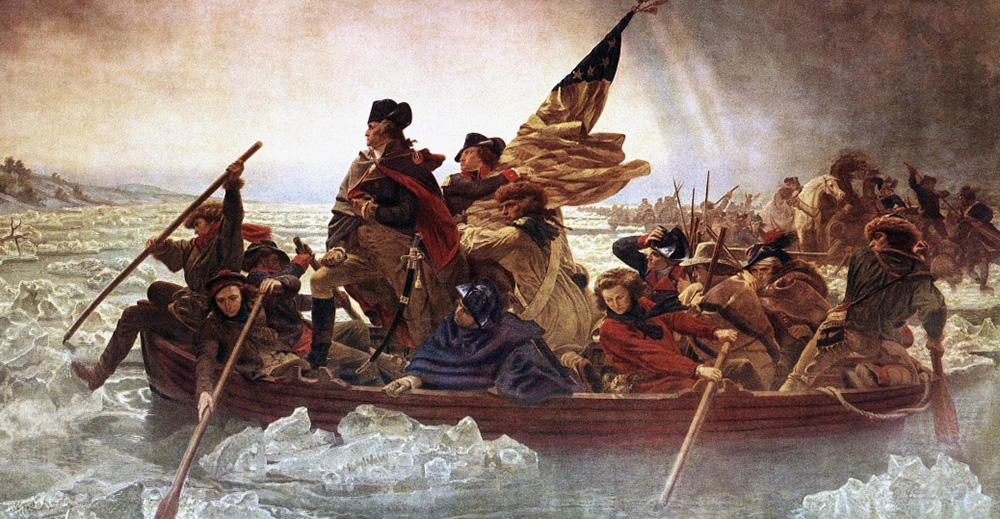- American Revolutions: A Continental History, 1750-1804
- W.W. Norton (2016)
Alan Taylor is a pre-eminent American historian, but he is no radical on the fringes. He is the Thomas Jefferson Memorial Foundation Professor of History at the University of Virginia, founded by Jefferson himself. He has won two Pulitzer Prizes and the Bancroft Prize for his earlier work. And in this book, he completely overthrows the sugar-coated mythology that American school children have been fed for over 200 years.
Instead of high-minded colonials united to fight the British oppressor, he shows us a savage civil war, with terrorist tactics used by both Loyalists and Patriots. Instead of the high-minded Founding Fathers, he shows us slaveowners who were also cold-blooded land speculators. Taylor’s 18th-century America is unpleasantly like its 21st-century version.
The American colonies had no aristocrats, but they had some very rich men — “gentlemen” who made up about five per cent of the population. The rest were farmers, tradesmen and labourers; 20 per cent were black slaves. Early on, the lower classes had struck an implicit deal with their betters: technically, all white men were equal and the superiors of women, blacks and the Indigenous nations known as Indians. That deal transformed class war into race war — and then into civil war.
Poor whites were fond of evangelical sects that emphasized individualism and self-sufficiency. They also wanted their own land, generally at the expense of the Indigenous peoples. Both Britain and the local gentlemen disliked this idea: Britain had treaties with Indigenous nations and didn’t want to spend money policing the frontier. And the genteel classes included big land speculators like George Washington and Thomas Jefferson who wanted to buy up vast tracts and then sell parcels to would-be pioneers.
Matters came to a head after Britain defeated France in the Seven Years’ War (1756-63). Britain acquired not just Quebec but the vast lands between the Appalachians and the Mississippi, previously controlled by Indigenous nations allied to France. Thousands of colonists were eager to drive the natives out and take over their lands.
Financially overstretched, Britain wanted nothing of the sort. Policing the west, and protecting Indigenous allies and land-hungry colonials from one another, would have been brutally expensive.
Spoiled brats versus arrogant fools
In effect, both the British and the colonials wanted to rule the west without actually having to pay for it. The British thought the colonials were spoiled-brat freeloaders; the colonials thought the Brits were arrogant fools. Both were right, and incidents in the 1770s sputtered toward armed violence.
Yet the revolution almost didn't happen. As late as 1775, Benjamin Franklin couldn’t imagine anyone seriously wanting to break away from the Empire. While the colonies could elect local representatives, only a few were qualified to vote — and only a quarter of those bothered to turn out. They preferred candidates who promised the lowest taxes. “Colonial America,” Taylor observes, “was a poor place to look for democracy.”
The colonials of all classes were divided: about a third of white men were Patriots who wanted independence. A third were Loyalists who didn’t. And a third sat on the fence. This was not a war of colonials against imperialists, but a civil war of colonials against one another, with rival empires using both sides in a proxy war.
“To win their civil war,” Taylor argues, “genteel Patriots had to build a cross-class coalition that appealed to thousands of men and women” — just as Donald Trump and his genteel plutocrats built a coalition of working-class and middle-class voters that beat the genteel plutocrats led by Hillary Clinton.
Training in domestic terrorism
Years of squabbles and riots over British taxes trained the Patriots in domestic terrorism — not just against the British and their officials, but against their own neighbours and relatives. Tarring and feathering a Loyalist was no prank but instead the sadistic application of hot tar to human skin (the feathers often came from pillows flung by housewives from their bedroom windows to the mob in the street). Loyalist newspapers were shut down; freedom of the press was a Patriot monopoly.
Even so, the Revolution was a near-run thing. Quebec and the rich Caribbean island colonies had no interest in breaking away. The Continental Congress had to print phony money to pay its soldiers (who often deserted). If the British had had competent generals, they could have erased Washington’s ragged army, which relied heavily on French support.
And having won, the 13 colonies nearly lost the peace. Britain treated the new U.S. just as the U.S. would later treat Fidel Castro’s Cuba. Deprived of access to the huge British market, the U.S. toppled into a 15-year depression — the worst before the 1930s. Settlers flooded west, starting wars with the natives and shipping their goods down the Mississippi to Spanish-controlled New Orleans. The states were far from united; New England had little in common with the south, which already relied on slave labour to produce monocultures like tobacco, cotton and indigo.
A hypocrites’ compromise
If the states were not to be picked off by European empires, or conquered by one another, something better was needed than the Articles of Confederation they were then living under. Hence the Constitution, which went through many drafts and much horse-trading before it emerged (and then immediately required 10 amendments, now known as the Bill of Rights). It was not a document for the ages, but the best compromise that could be worked out at the moment.
That compromise had to accept the hypocrisy of liberty-loving slaveowners — and to give them extra voting clout by counting each of their slaves as 3/5 of a white person. So the South got more representatives than it deserved, and has held a death grip on American politics ever since (except for the decade after the Civil War).
Taylor doesn’t moralize about the nastiness of Patriots versus Loyalists, or the cynicism of the empires that tried to exploit the revolution for their own benefit. Stripped of mythology, the facts speak for themselves.
He also gives his book an epic scope, by showing us the “revolutions” all over North America and the Caribbean — most of which, like that in Quebec, failed. Europe’s empires worried that the 13 colonies would inspire their own colonies to revolt, and they were right. Haiti broke away from the French in 1804, soon followed by Spain’s American colonies.
By then the Americans were embarked on two centuries of party politics, with Thomas Jefferson elected president in 1800 as a Republican opposed to the Federalist effort to create a strong central government. He wanted the states to have all the responsibilities except foreign affairs and a minimal army and navy — and minimal taxes to pay for them.
The first populist, Jefferson ditched the quasi-regal presidential coaches, pretending to a public modesty while privately living very well. “Thereafter,” Taylor observes, “Americans accepted government by wealthy men so long as they pretended to have common manners.” Future oligarch-presidents followed his example: Teddy Roosevelt never let himself be photographed playing tennis (then a rich man’s game), and we are all too familiar with Donald Trump’s fondness for well-done steaks doused with ketchup.
Jefferson’s Republicans also promoted white settlement in the west. “Where Federalists had treated settlers as ‘white savages’ who needed elite mentors,” says Taylor, “Republicans celebrated them as industrious farmers who redeemed a wilderness through hard work.” The stage was set for the second American Civil War, and perhaps for a third: the rhetoric of freedom and the reality of race war.
“Like a kaleidoscope,” Taylor concludes, “we continue in every generation to make new combinations of clashing principles derived from the enduring importance and incompleteness of our revolution. The revolution remains embedded as selective memory in every contemporary debate.... Instead of offering a single, cohesive, and enduring plan, the diverse founders generated contradictions that continue to divide Americans.”
Canadians too remain divided. Northrop Frye called us “Americans who reject the Revolution.” But which Revolution? The white-trash racist revolution, or the truly democratic revolution? Some day, likely soon, we will have to decide. ![]()
Read more: Politics

















Tyee Commenting Guidelines
Comments that violate guidelines risk being deleted, and violations may result in a temporary or permanent user ban. Maintain the spirit of good conversation to stay in the discussion.
*Please note The Tyee is not a forum for spreading misinformation about COVID-19, denying its existence or minimizing its risk to public health.
Do:
Do not: